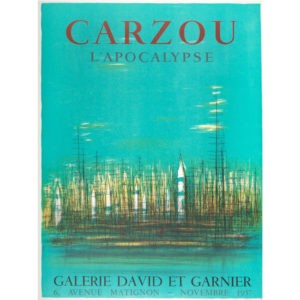Carzou, Jean
Jean Carzou, whose birth name was Karnik Zouloumian, was a French painter, lithographer, etcher and decorator of Armenian origin. Read the biography
4 résultats affichésTrié du plus récent au plus ancien
-

The Apocalypse
Jean Carzou
90€
-

Provence
Jean Carzou
SOLD
-

Paintings & Watercolors
Jean Carzou
SOLD
-

Summer light
Jean Carzou
60€
Biography
Jean Carzou, whose birth name was Karnik Zouloumian, was a French painter, lithographer, etching and drypoint engraver and decorator of Armenian origin. He was born in Aleppo (Syria) on January 1, 1907. In 1924, he was awarded a scholarship to study architecture in Paris, where he eventually became a self-taught painter, freely attending academies in the Montparnasse district, such as the Académie de la Grande Chaumière. In his youth, he survived thanks to his caricatures of politicians, which were published in the press. In 1939, he held his first solo exhibition at the Galerie Contemporaine, rue de Seine, where he was already recognized for the strength of his line and the power of his work. It was the first in a series of over a hundred one-man shows of his work in Paris, the provinces and abroad. Among the most notable are Venise (1953), L'Apocalypse (1957), Figures rituelles (1968) and Versailles (1994). Throughout his career, he exhibited regularly at the Salons des Indépendants and the Salon d'Automne, as well as at numerous regional and international events. In 1973, he designed the poster for the Salon d'Automne Hommage à Paris, printed by Fernand Mourlot.
Carzou constantly diversified his techniques. In the 1950s, he began designing sets for the theater; his work on Jean-Phillipe Rameau's Indes Galantes established his reputation. He also created numerous tapestries. In 1977, he was admitted to the Académie des Beaux-arts, where, right from his entrance speech, he embodied a strong distrust of modern society in general and modern art in particular. He railed against Cubism and fiercely criticized the liberation of painting, which he saw as almost apocalyptic. À Paul Cézanne and Pablo Picassohe preferred painters such as Antoine Watteau and Salvador Dalí.
In 1990, he created a gigantic Apocalypse for the walls of the Église de la Présentation in Manosque (Alpes de Haute Provence), featuring devastated landscapes, rails and darkened ships that evoke his obsession with war and the holocaust. The site became the Fondation Carzou in 1991.
In the course of his career, Carzou received numerous awards: he was named Officier de la Légion d'honneur and Commandeur de l'ordre des arts et des lettres, he was First Prize winner of the Salon des peintres témoins de leur temps in 1952, three-time winner of the Hallmark Prize (1949, 1952, 1955), Grand Prix de l'Éducation nationale in Tokyo in 1955 and Grand Prix Europe at the first Bruges Biennial in 1958. He died on August 12, 2000 and is buried in the Montparnasse cemetery.
Carzou and printmaking
Lithography and illustration play a fundamental role in Jean Carzou's work. He produced numerous illustrated books, including Provence in 1966, Les Illuminations in 1969, La Nuit des rois in 1974, and Paris sur Seine in 1986. Carzou's style is immediately recognizable in his paintings and engravings, where he plays with the representation of reality, conjuring up elements of disaster and science fiction in landscapes of town and country. His work speaks of an anguish that never lapses into pathos and never loses a certain poetic quality. The lithographed posters and book illustrations offered by Galerie Arenthon bear witness to these silent atmospheres, menaced by lines of fangs and thorns bathed in dreamlike light. The landscapes of Provence, with their teeming graphics, cathedrals, buildings and forests, create an atmosphere that is both eerie and fairytale-like.
